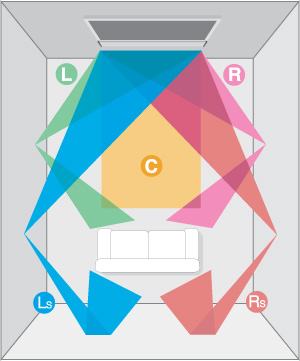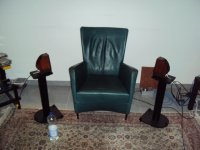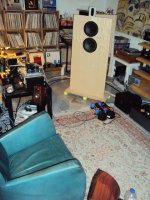Hi,
Well, in both cases the speakers are in front of the listener and sound reaches the listener generally not directly, HF is rolled off.
Super Stereo needed/needs a specific relation to the front speakers which indicates some form of time alignment.
Without analysing actual Super Stereo circuitry in detail it is hard to say if they actually used simply a single analogue delayed signal or multiple ones.
The principles and claimed results seems rather more similar than different.
BTW, I have encountered Super Stereo many times at HiFi Show's (the UK people selling it where very enthusiastic) and whenever quality main speakers where used I preferred without Super Stereo.
Of course, anyone may use whatever effects they like or desire.
Ciao T
I've read about that system, but it seems to be somewhat different. Their side speakers are slightly in front of the listener, facing the front speakers. If I interpret the description correctly, they're not producing the same signal as the front speakers, time aligned at the listening position, but simply various delayed signals to enhance the feeling of spaciousness.
Please correct me if I'm wrong.
Well, in both cases the speakers are in front of the listener and sound reaches the listener generally not directly, HF is rolled off.
Super Stereo needed/needs a specific relation to the front speakers which indicates some form of time alignment.
Without analysing actual Super Stereo circuitry in detail it is hard to say if they actually used simply a single analogue delayed signal or multiple ones.
The principles and claimed results seems rather more similar than different.
BTW, I have encountered Super Stereo many times at HiFi Show's (the UK people selling it where very enthusiastic) and whenever quality main speakers where used I preferred without Super Stereo.
Of course, anyone may use whatever effects they like or desire.
Ciao T
I think you've got that backwards . . . completely backwards. The "principles" are as different as using delay to time-align the signals and using delay to add artifical reverb, and the "claimed results" . . . greater spaciousness on the one hand and better localization on the other . . . well . . . not much "similarity" there . . .The principles and claimed results seems rather more similar than different.
I'm thinking you're not understanding what Linkwitz is doing . . .
Member
Joined 2009
Regarding implementation, the WATSON concept could easily be implemented with soundbar phased array technology (and a shoebox room). WAF is high but so is the price.
YAMAHA :: YSP-1

(the picture shows a typical 5.1 surround sound setup)
YAMAHA :: YSP-1

(the picture shows a typical 5.1 surround sound setup)
I think you've got that backwards . . . completely backwards. The "principles" are as different as using delay to time-align the signals and using delay to add artifical reverb, and...........................................................................................
the "claimed results" . . . greater spaciousness on the one hand and better localization on the other................................................................................................................
. . . well . . . not much "similarity" there....I'm thinking you're not understanding what Linkwitz is doing . . .
Hi there: Maybe the DIY community could combine the two "principles" to obtain the claimed result, ie greater spaciousness and better locilization"!......regards, Michael
Regarding implementation, the WATSON concept could easily be implemented with soundbar phased array technology (and a shoebox room). WAF is high but so is the price.
YAMAHA :: YSP-1

(the picture shows a typical 5.1 surround sound setup)
Played around with one a touch yesterday. I didn't come away impressed, but it sounded a lot better than TV speakers and did look sharp.
Have you ever listened to band limited noise over headphones and level-panned it from left to right?
What does it help to be able to shift sound from one ear to another inside one's head ? It would not help in extracting the localisation cues from the recorded sound event.
In natural sound field there is no low freq ILD. What is available is only ITD.
- Elias
Regarding implementation, the WATSON concept could easily be implemented with soundbar phased array technology (and a shoebox room). WAF is high but so is the price.
YAMAHA :: YSP-1

(the picture shows a typical 5.1 surround sound setup)
That will not enhance low freq ITD.
- Elias
What does it help to be able to shift sound from one ear to another inside one's head ?
It tells us that simple sound field observations don't explain how our hearing works.
Today i set up my Watsons. I decided on the most simple implementation without delay.
I am using the Kiso Acoustics HB Mini, a gift given to me by Hara San. I set them up on a low stand so that they actually fire against my stomach. I am not using a volume control because they are of much lower sensitivity then my 95dB MPL baffles. The low stand rolls off the highs at the ears so i do not even use a filter over 2khz.
I have not listened much but listening to the Watsons alone is very revealing. There is enormous depth of image, totally free from the Watsons and also surprising width. Focus is very good, much higher then the low sitting speakers, it´s quite a party trick.
Tomorrow i will listen more carefull to a variety of programm material.
I am using the Kiso Acoustics HB Mini, a gift given to me by Hara San. I set them up on a low stand so that they actually fire against my stomach. I am not using a volume control because they are of much lower sensitivity then my 95dB MPL baffles. The low stand rolls off the highs at the ears so i do not even use a filter over 2khz.
I have not listened much but listening to the Watsons alone is very revealing. There is enormous depth of image, totally free from the Watsons and also surprising width. Focus is very good, much higher then the low sitting speakers, it´s quite a party trick.
Tomorrow i will listen more carefull to a variety of programm material.
Attachments
Last edited:
Today i set up my Watsons. I decided on the most simple implementation without delay.
Would love to hear how the sound changes when the appropriate delay is introduced. Right now your mains probably act as "reflection generators".
The Watsons are not audible when the main speakers are playing. As i said, they are only in ca. 70cm height and they are tiny. Anyway, i have Beringer equipment that can do that in a minute.
On the other hand i have phenomenons now that deserve a closer look. There is something new going on here.
On the other hand i have phenomenons now that deserve a closer look. There is something new going on here.
The Watsons are not audible when the main speakers are playing. As i said, they are only in ca. 70cm height and they are tiny. Anyway, i have Beringer equipment that can do that in a minute.
On the other hand i have phenomenons now that deserve a closer look. There is something new going on here.
Of course they are not audible or do you normally hear room reflections as a distinct sound separate from the direct sound? That's only going to happen when a reflection is delayed by more than 30-80ms.
In your case the "Watsons" deliver the direct sound and the main speakers act as room reflections. Both sources are melted into one sound perception with additional spaciouness because of the difference in delay and direction. See precedence effect.
Last edited:
Of course they are not audible or do you normally hear room reflections as a distinct sound separate from the direct sound?
Perhaps we should make a distinction between an audible difference (timbre, sound stage width etc) compared to front speakers only, and hearing a spatially distinct auditory event.
Perhaps we should make a distinction between an audible difference (timbre, sound stage width etc) compared to front speakers only, and hearing a spatially distinct auditory event.
Not sure why this is necessary? An additional distinct auditory event would be an echo. All other descriptors like apparent source width, envelopment, timbre, etc. don't describe a distinct auditory event. They describes spatial and/or spectral characteristics or qualities of an auditory event.
A distinct auditory event is not necessarily an echo.
Anyway, there's an interesting update: WATSON-Stereo Enhancement Loudspeakers
Anyway, there's an interesting update: WATSON-Stereo Enhancement Loudspeakers
A distinct auditory event is not necessarily an echo.
Then please give a definition so we don't talk past each other.
- Home
- Loudspeakers
- Multi-Way
- Linkwitzlab "Watson"

